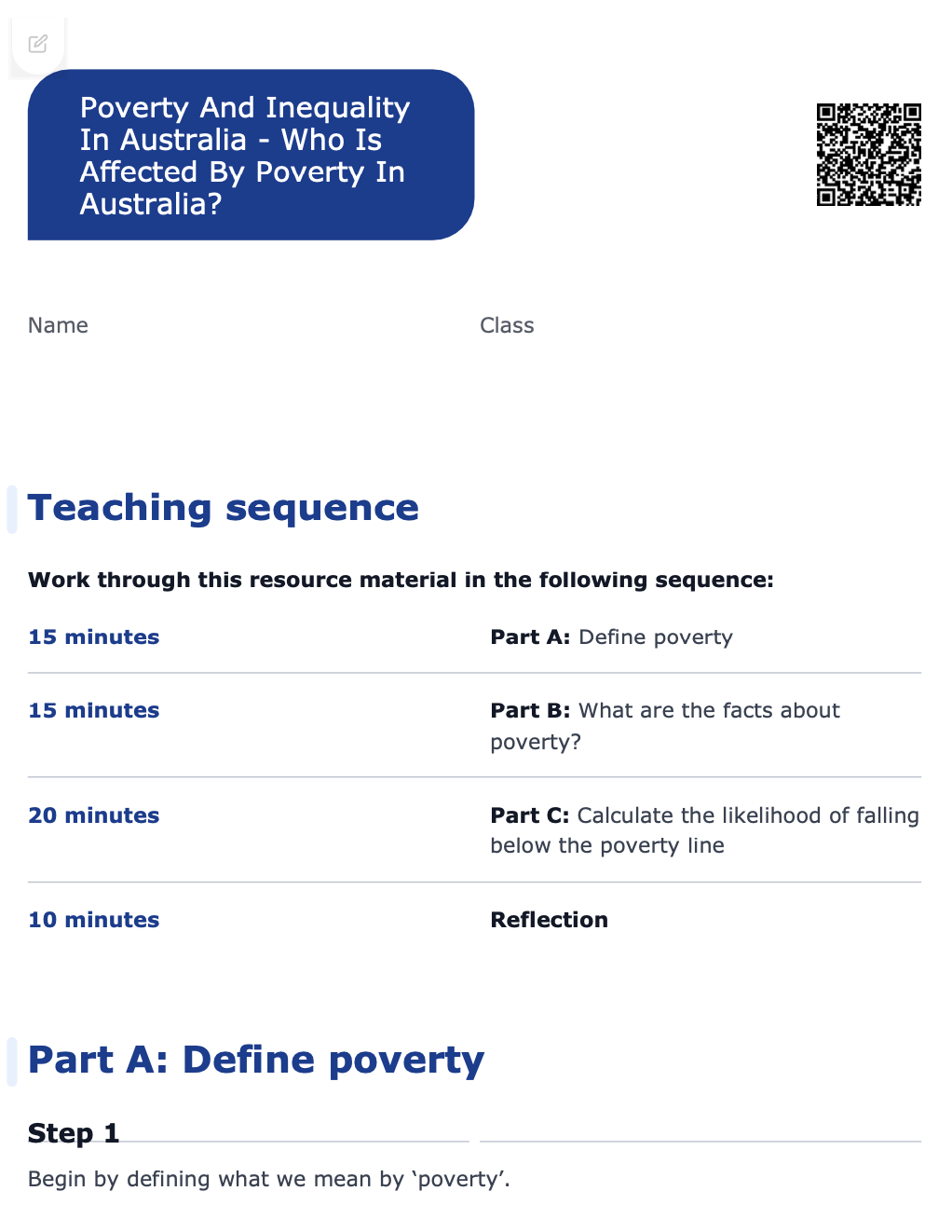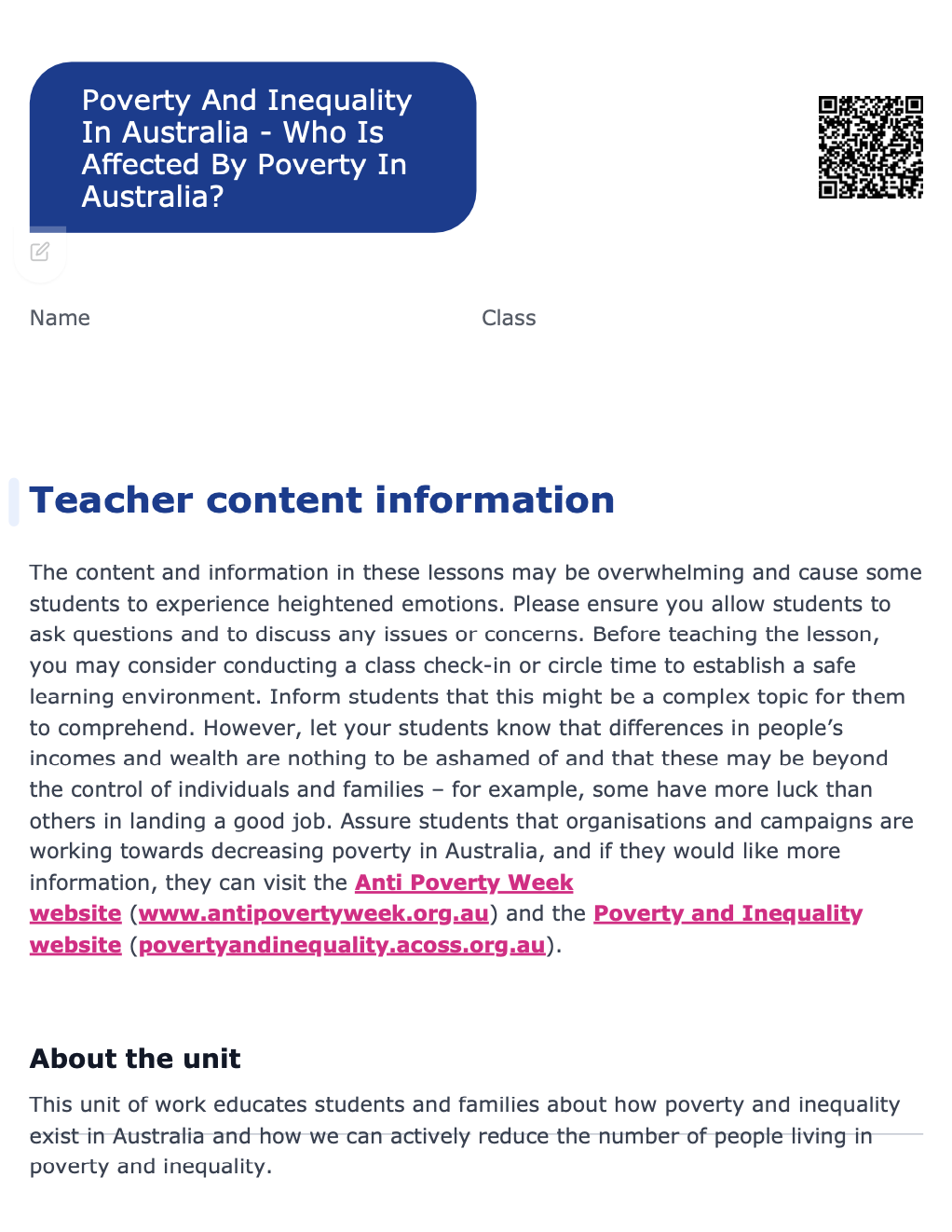Lesson summary
Australia has enjoyed close to 30 years of positive economic growth with only some minor hiccups. However, many households and communities are experiencing high rates of poverty. Could it be that the average Australian is at risk of poverty? Some groups of people are more at risk of poverty than others. Factors such as age, gender, family relationships, paid work and sources of income, disability, and other characteristics can all impact poverty risks.
This lesson will present students with some recent facts about people experiencing poverty in Australia. Students will analyse current statistics and do some calculations to determine which factors contribute to the chances of falling below the poverty line.
Learning intentions:
Students will...
- analyse the factors that contribute to poverty in Australia
- calculate the likelihood of experiencing poverty.
Success criteria:
Students can...
- interpret data from primary sources
- perform calculations and organise data to reveal valuable comparisons
- analyse and critically evaluate the chances of living below the poverty line in Australia.
Lesson guides and printables
Lesson details
Curriculum Mapping
Australian Curriculum content descriptions:
Years 5 Mathematics:
- Solve problems involving multiplication of large numbers by one- or two-digit numbers using efficient mental, written strategies and appropriate digital technologies (ACMNA100)
- Use efficient mental and written strategies and apply appropriate digital technologies to solve problems (ACMNA291)
- Describe and interpret different data sets in context (ACMSP120)
- Solve problems involving division by a one digit number, including those that result in a remainder (ACMNA101)
Years 6 Mathematics:
- Select and apply efficient mental and written strategies and appropriate digital technologies to solve problems involving all four operations with whole numbers (ACMNA123)
- Multiply decimals by whole numbers and perform divisions by non-zero whole numbers where the results are terminating decimals, with and without digital technologies (ACMNA129)
- Interpret and compare a range of data displays, including side-by-side column graphs for two categorical variables (ACMSP147)
Syllabus outcomes: MA3-2WM, MA3-5NA, MA3-6NA, MA3-7NA
General capabilities: Numeracy; Critical and Creative Thinking; Ethical understanding
Relevant parts of Year 5 achievement standards:
By the end of year 5, students identify and explain strategies for finding unknown quantities in number sentences involving the four operations. They explain plans for simple budgets. Students connect three-dimensional objects with their two-dimensional representations. They describe transformations of two-dimensional shapes and identify line and rotational symmetry. Students interpret different data sets.
Relevant parts of Year 6 achievement standards:
By the end of year 6, students solve problems involving all four operations with whole numbers. Students connect fractions, decimals and percentages as different representations of the same number. They solve problems involving the addition and subtraction of related fractions. Students make connections between the powers of 10 and the multiplication and division of decimals. They describe rules used in sequences involving whole numbers, fractions and decimals. Students connect decimal representations to the metric system and choose appropriate units of measurement to perform a calculation. They make connections between capacity and volume. They solve problems involving length and area. They interpret timetables. Students describe combinations of transformations. They solve problems using the properties of angles. Students compare observed and expected frequencies. They interpret and compare a variety of data displays including those displays for two categorical variables. They interpret secondary data displayed in the media.
Students locate fractions and integers on a number line. They calculate a simple fraction of a quantity. They add, subtract and multiply decimals and divide decimals where the result is rational. Students calculate common percentage discounts on sale items. They write correct number sentences using brackets and order of operations.
Resources Required
- A device capable of presenting a video to the class
- A device capable of delivering a PowerPoint presentation on the: Chances of living in poverty
- Student Workbook, paper or working device to show working out
Skills
This lesson is designed to build students’ competencies in the following skills:
- creativity
- critical thinking
- cultural understanding
- digital literacy
- ethical understanding
- empathy
- problem solving
Additional Info
Time required: 60 mins
Level of teacher scaffolding: Medium – facilitate class discussion and show examples of working out.
These lessons have been designed in consultation with Anti-Poverty Week and ACOSS/UNSW Poverty and Inequality Partnership.
The content and information in these lessons may be overwhelming and cause some students to experience heightened emotions.
Please ensure you allow students to ask questions and to discuss any issues or concerns. Before teaching the lesson, you may consider conducting a class check-in or circle time to establish a safe learning environment. Inform students that this might be a complex topic for them to comprehend. However, let your students know that differences in people’s incomes and wealth are nothing to be ashamed of and that these may be beyond the control of individuals and families – for example, some have more luck than others in landing a good job.
Assure students that organisations and campaigns are working towards decreasing poverty in Australia, and if they would like more information, they can visit the Anti Poverty Week website and the Poverty and Inequality website.




Welcome back!
Don't have an account yet?
Log in with:
By signing up to Cool.org you consent and agree to Cool's privacy policy to
store, manage and process your personal information. To read more, please see
our privacy policy here(Opens in new tab).
Create your free Cool.org account.
Many of our resources are free, with an option to upgrade to Cool+ for premium content.
Already have an account?
Sign up with:
By signing up to Cool.org you consent and agree to Cool's privacy policy to
store, manage and process your personal information. To read more, please see
our privacy policy here(Opens in new tab).